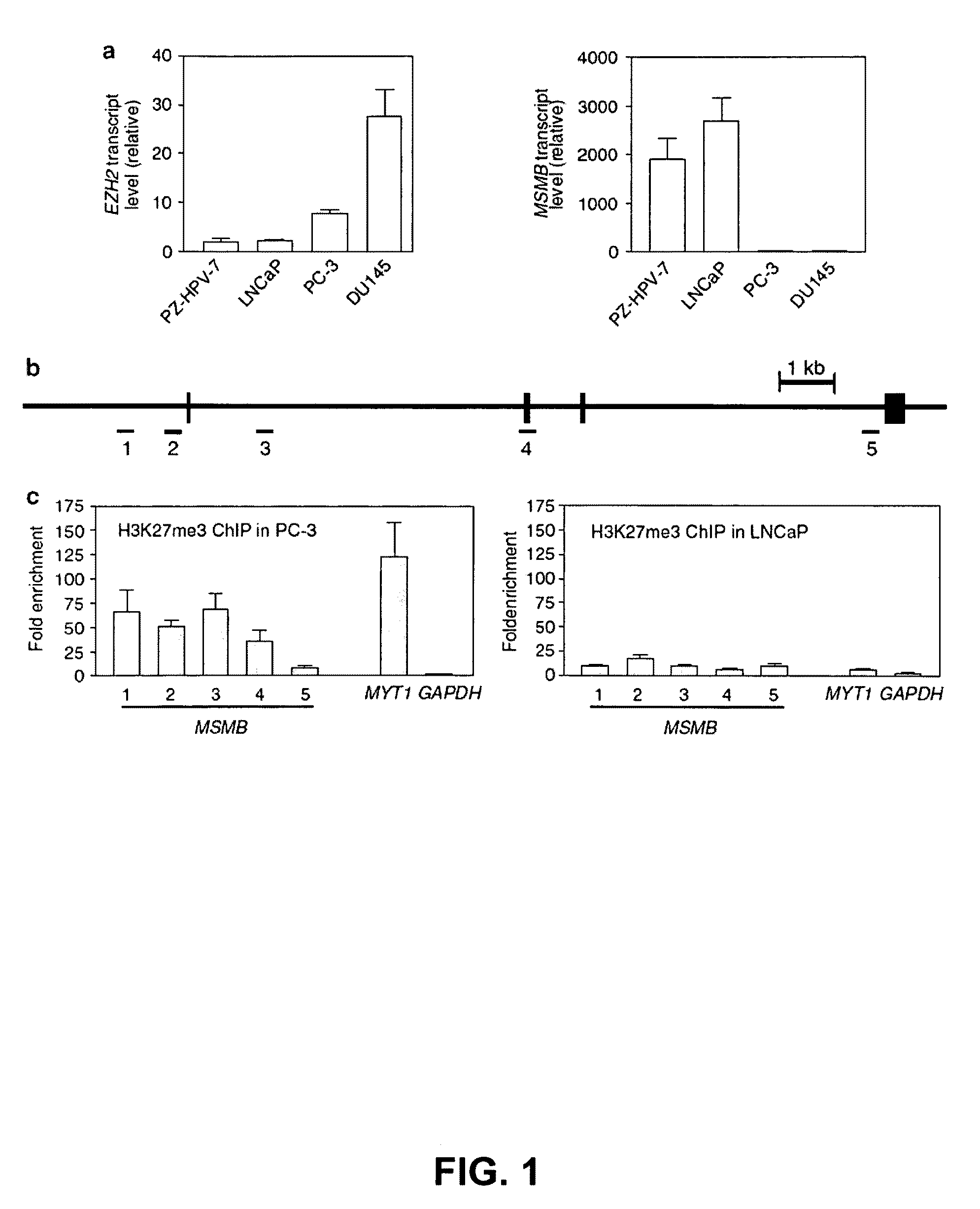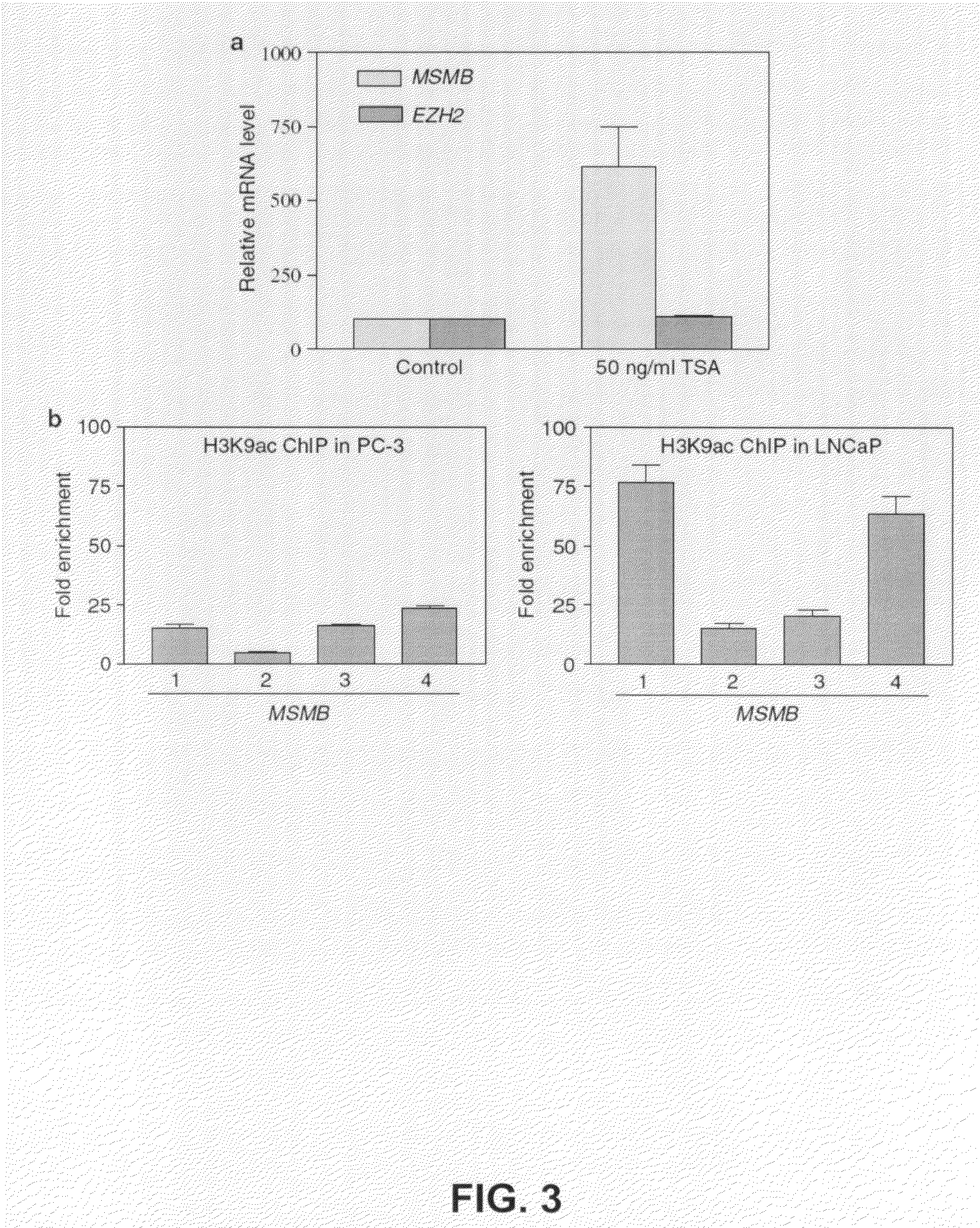MSMB-gene based diagnosis, staging and prognosis of prostate cancer
a prostate cancer and gene technology, applied in the field of medicine and biotechnology, can solve the problems of reducing life expectancy, refractory to hormone therapy, and affecting the prognosis of prostate cancer, and achieve the effect of reducing the loss of gene function
- Summary
- Abstract
- Description
- Claims
- Application Information
AI Technical Summary
Benefits of technology
Problems solved by technology
Method used
Image
Examples
example 1
DNA Methylation Analysis
[0150]DNA methylation is an epigenetic event that affects cell function by altering gene expression and refers to the covalent addition of a methyl group, catalyzed by DNA methyltransferase (DNMT), to the 5-carbon of cytosine in a CpG dinucleotide. Methods for DNA methylation analysis can be divided roughly into two types: global and gene-specific methylation analysis. For global methylation analysis, there are methods which measure the overall level of methyl cytosines in genome such as chromatographic methods and methyl accepting capacity assay. For gene-specific methylation analysis, a large number of techniques have been developed. Most early studies used methylation-sensitive restriction enzymes to digest DNA followed by Southern detection or PCR amplification. Recently, bisulfite reaction-based methods have become very popular such as methylation specific PCR (MSP), bisulfite genomic sequencing PCR. Additionally, in order to identify unknown methylation...
example 2
Quantitative Methyl-Specific PCR (qMSP)
[0151]Quantitative Methyl-Specific PCR (qMSP) (J. G. Herman et al., Proc. Natl. Acad. Sci. USA Vol. 93, pp. 9821-9826, September 1996) is the ideal technology for early detection of PrCa. The detection of DNA methylation is based on bisulphite treatment of DNA, which reproducibly converts unmethylated cytosine into uracil. In this assay, the methylated cytosines remain unchanged. The bisulphite conversion is combined with a PCR-based approach known as Methylation-Specific PCR (MSP). This technique has been described enabling in U.S. Pat. Nos. 5,786,146, 6,017,704, 6,265,171, and 6,200,756 and is hereby incorporated by reference. It has major advantages over other PrCa screening methods:
[0152]The qMSP technology is extremely sensitive and can detect one to ten tumor cells among thousands of healthy cells.
[0153]The qMSP technology is highly reproducible, quick and easy to perform.
[0154]It is a low-cost assay only requiring standard qPCR equipment...
example 3
Predicted CpG Islands from the MSMB Gene
[0156]A detailed bioinformatical analysis of 15 kbp region upstream and downstream of the transcriptional start site of the MSMB gene resulted in the prediction of 10 CpG islands. All CpG islands, except for CpG5 and 7, are predicted by the program Newcpgreport, with the following parameters: window=50, window shift=1, Island size>200, GC %>0.2 and O / E (observed / predicted>0.2. CpG5 and 7 island are predicted by the program Methprimer with the following parameters: Island size>100, GC %>0.5 and O / E>0.6 A schematic representation and localization of the predicted CpG islands has been displayed in FIG. 6 and Table 1.
PUM
| Property | Measurement | Unit |
|---|---|---|
| pH | aaaaa | aaaaa |
| size | aaaaa | aaaaa |
| size | aaaaa | aaaaa |
Abstract
Description
Claims
Application Information
 Login to View More
Login to View More - R&D
- Intellectual Property
- Life Sciences
- Materials
- Tech Scout
- Unparalleled Data Quality
- Higher Quality Content
- 60% Fewer Hallucinations
Browse by: Latest US Patents, China's latest patents, Technical Efficacy Thesaurus, Application Domain, Technology Topic, Popular Technical Reports.
© 2025 PatSnap. All rights reserved.Legal|Privacy policy|Modern Slavery Act Transparency Statement|Sitemap|About US| Contact US: help@patsnap.com



